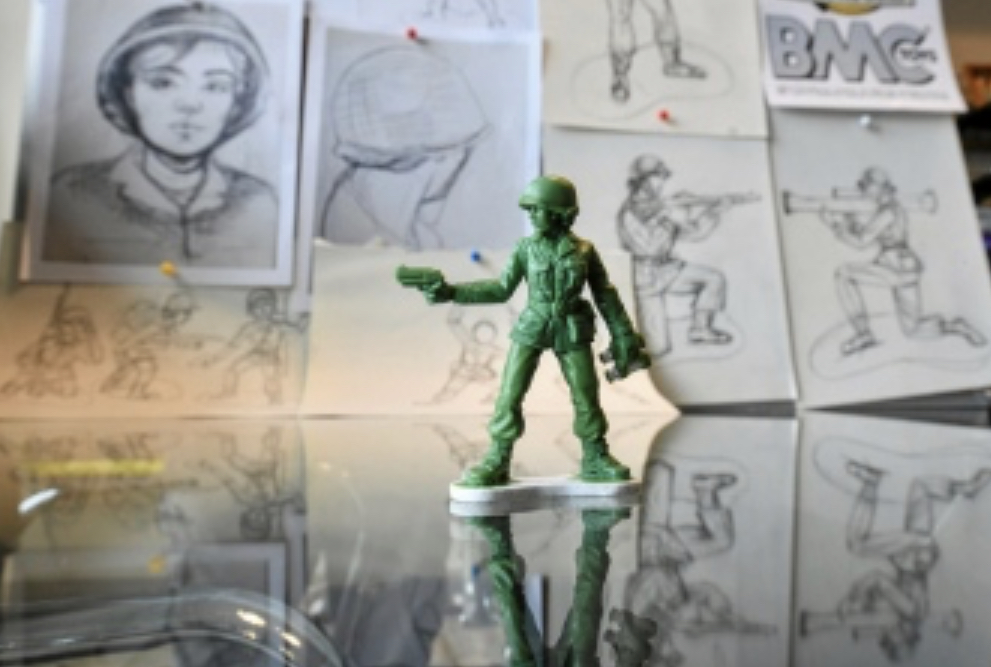By Jon O’Connell
The Times-Tribune, Scranton, Pa.
WWR Article Summary (tl;dr) A 6-year-old girl from Arkansas led the effort to get a toymaker to start creating little green army WOMEN along with the male figures the company was already producing.
SCRANTON
Her feet might be stuck to a little plastic platform, but a new twist on an old toy is off and running.
North Scranton toymaker Jeff Imel, owner of BMC Toys, whose little green army men are mostly cast from decades-old male soldier molds, had been kicking around the idea of making green army women for years.
A letter he received from a 6-year-old girl named Vivian from Little Rock, Arkansas, last month — and the deluge of media interest after he blogged about it — triggered him to act.
Women are in the army, too, Vivian said. So why can’t girls like her buy green army women?
” … So (please) can you make army girls that look like women. I would play with them (every day) and my (friends) would, (too)!” she wrote in the letter.
Imel, 49, is in the final stages of designing four female figurines in full battle gear, posed for action.
They should be ready for market by Christmas 2020.
With few exceptions, no toy company has translated the iconic toy into a woman. One reason: most of the toys are modeled after World War I and World War II fighters, and women rarely fought in those wars.
The toymaker has one woman figurine, circa 1950s, who carries a lantern. It’s a nod to the 19th century British military nurse and reformer Florence Nightingale, who was known as “the lady with the lamp,” but that’s about it. Most tiny female figurines cast in solid drab plastic aren’t packing heat.
Empowered women
Imel’s not exactly entering uncharted territory.
Major toy companies have rolled out new lines, fueled by pop culture trends and the equal treatment movement, that barrel into boyhood strongholds.
“We’ve seen small inroads made with inclusion of girls in areas that are traditionally more boy oriented. The first is with action heroes,” said Juli Lennett, a U.S. toy industry analyst for the market research firm NPD Group.
“There have been a number of female action heroes, tied to TV and movies that have been re-created in the toy aisle,” she said.
She points to Lego’s 2012 launch of Lego Friends and subsequent lines targeting girls with the stacking block kits, once made mostly for boys.
The Marvel and DC superhero worlds tapped the equality movement with blockbuster films cast around women and women heroes saving the day in step with the boys.
A toy story begins
Imel’s been selling things online since the late 1990s, the dawn of e-commerce. One of his vendors was Bill McMaster, a well-regarded toymaker who founded BMC Toys in 1991.
When McMaster died in 2014, Imel bought the assets of his business.
Now he uses legacy molds that span decades, from the 1950s to his most recent from around 2000, he said. While the BMC toys historically and still are made in China, he’s found ways to bring some production to the U.S. with other molds, including his most recent manufacturer, Northeastern Plastics Inc. on Penn Avenue in Scranton, which puts him closer to the production.
Until now, the only new design he made was a model bunker, and even that modified an existing design.
“It’s expensive to have new molds made,” he said. “This particular project, the plastic army women, soup to nuts, it’s probably the cost of a modest new car.”
Imel serves a slightly higher-end market; for example, a 40-piece playset, cast from a 1950s-era mold, costs almost $15. By comparison, Walmart sells a 144-piece set for around $9.
“I grew up playing with those army men,” said C. Britt Beemer, a Florida-based consumer behavior consultant. “I used to have cherry bombs and make them as mines … seven or eight guys would go flying into the sky.”
Imel’s off to a strong start with appearances in the national news and on toy and military blogs.
But in a world where social media influencers steer retail trends, Beemer suggested getting the toys in the hands of a celebrity, or his or her child, could pour fuel on his rising celebrity.
“Army men have seen a resurgence in sales in the last few years,” Beemer said. “I don’t know how many women would be playing with army men, but anything that’s new is going to get people’s attention so I would give it a shot.”
___
Distributed by Tribune Content Agency, LLC.














































































































































































































































































































































































